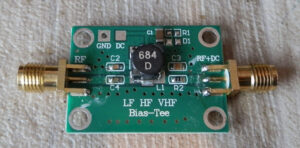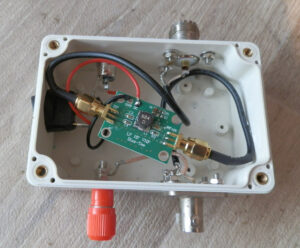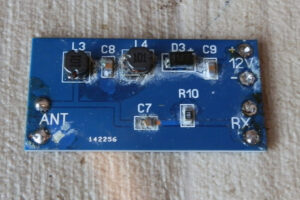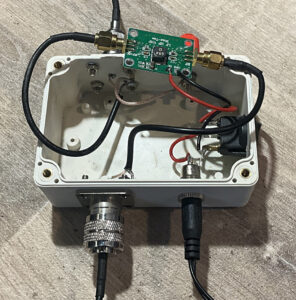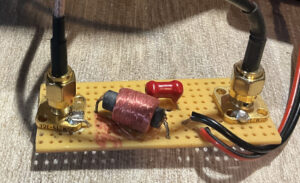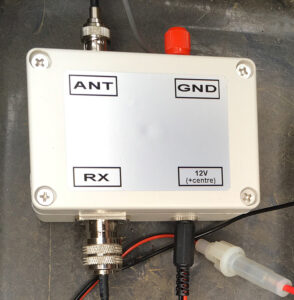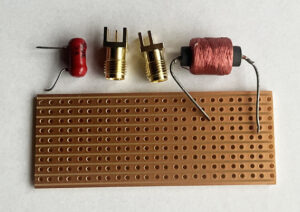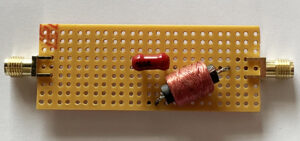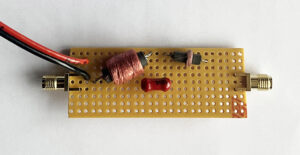Bias Tee 12 Volt Supply
Mini Whip Problems.
I wondered why the short wave bands were so quiet one evening when I was tuning around. After some investigation, I discovered that my MiniWhip active antenna had lost its 12 volt supply. The Bias Tee board, that came with the Miniwhip, had blown up! Sadly, water had found its way into the box after some heavy rain. The wrecked board is pictured below on the right.
I found a replacement bias tee online, pictured on the left below. The cost of the new board was £4.00 which included postage. I really didn’t think that it was going to be any good for that price! However, I placed it in the box and connected it up to the Miniwhip, and it worked! I didn’t doubt that it wouldn’t supply the necessary voltage to the antenna but, would it isolate the DC and RF properly? The set up worked reasonably well.
Experimental Bias Tee:
Most Bias Tee boards I’ve seen advertised seem to cover 10MHz to several GHz. The new one I bought, pictured below left, works fairly well on long and medium wave, so why state 10MHz as the lowest frequency? I’m interested in VLF, MF and HF so I thought I’d carry out a few experiments.
The centre photo shows an RF choke and capacitor I’ve mounted on a piece of Vero Board. I’ve ordered some PCB edge fitting SMA sockets to make a better job of it. This is the sort of RF choke used to feed HT to the anode of a transmitting valve, such as an 807, so it should be good for HF. I’m not interested in anything above 30MHz. But what about long and medium wave?
The value of the ceramic capacitor is 2500pF (2.5 nanofarad). The choke reads 5mH on my meter. DC resistance of the choke is 14.8 ohms. Both components were picked at random. I’ve mounted the Vero Board in the box, right hand photo, and connected it up.
Results using the RF choke:
Compared to the original bias tee board, my RF choke idea works very well. I’ve carried out comparisons on various frequencies and I’m pleased with the results. In fact, it appears to be better than the original. The receiver’s S meter reads a little higher and the noise level has reduced slightly. This could be coincidence, time and further tests will tell. There’s something else which is vastly improved, and that is the reception of the NDB for aircraft.
Results using my SDRuno:
Using SDRuno on my PC with my MiniWhip has never been very successful. The main problem has been breakthrough from local medium wave stations when I’m tuning around long wave or VLF. Now that I’m using my RF choke Bias Tee, breakthrough is greatly reduced. I’m not sure why this should be, so I will have to look into it. Medium wave is also much better with far less breakthrough from strong local stations.
I have a very long two core cable from the Bias Tee in the garden to an on off switch in the house. It is possible that this was acting as an antenna, picking up strong local signals and injecting them into the system. If this was the case, they are now being blocked by the RF choke. It’s just a thought.
A selection of RF chokes:
I have quite a selection of RF chokes. No doubt some would be better than other for the Bias Tee. I might carry out some comparison tests at some stage.
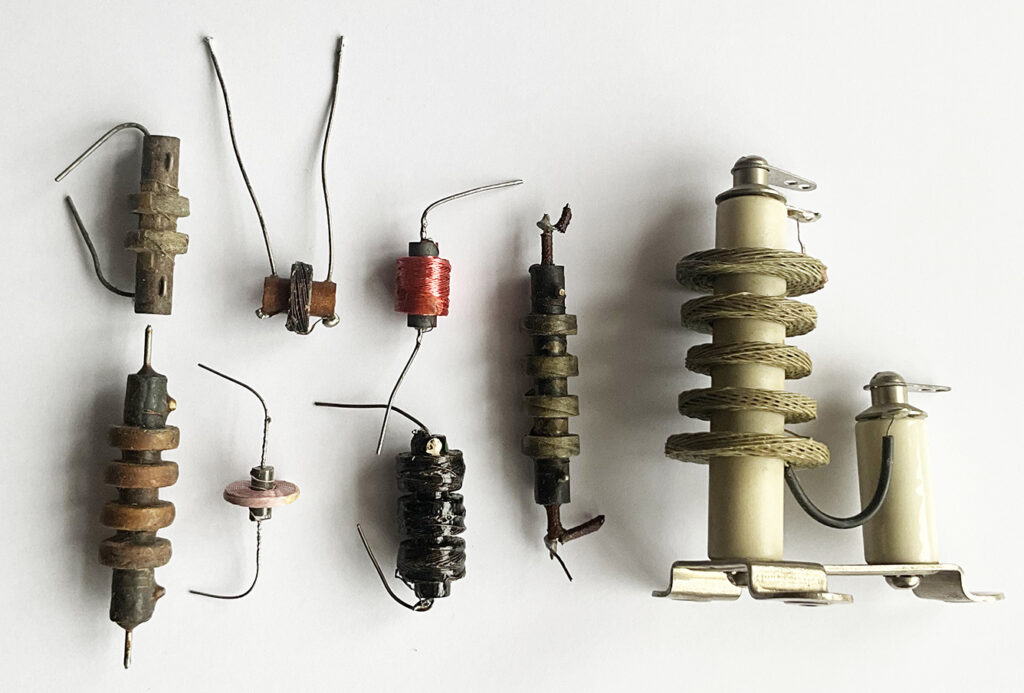
A new Bias Tee:
This has just arrived. It’s advertised as covering 200KHz to 180MHz. My measurements: 56uH. Zero ohms. Test results are interesting. The unit below is a little better than my homebrew around 25MHz but not quite so good at VLF. My unit is better at VLF but not quite so good around 25MHz. My unit introduces a small amount of unstable whistling around 25MHz but the signals are as good.
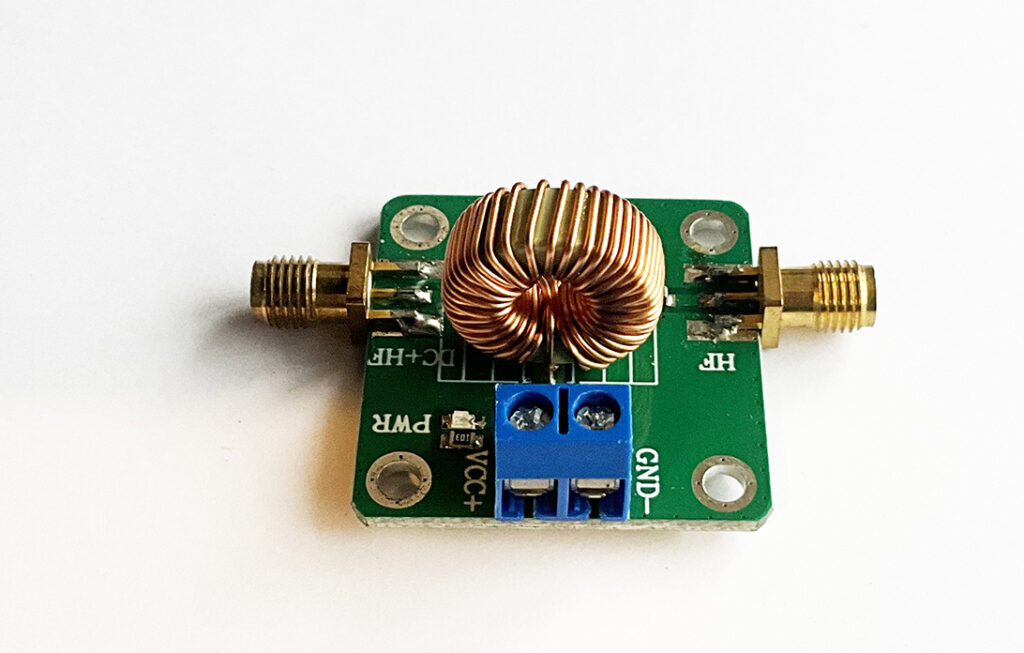
10/1/25. Homebrew MK3:
I now have the PCB edge type SMA sockets, see photos below, so I’ve be constructed another homebrew Bias Tee. Thanks to those who suggested wiring two RF chokes in series. The idea being a large choke for VLF and a smaller one for the 30MHz end of the HF spectrum. This is something I’ll be looking into. There’s plenty of room on the Vero Board for another choke.
Update. 11/1/25:
I’ve now added another, smaller, RF choke in series with the larger one. The additional choke is 40uH at 1 ohm. The idea is to lessen RF attenuation between VLF to 30MHz. See photo below.
Reception reports 11/1/25 at 1230 hours GMT.
Test results so far are excellent. I’m hearing more stations on the 13 metre broadcast band than ever before. The BBC transmission from Madagascar on 21.660MHz is very strong. Romania on 21.470MHz is romping in! The VLF end of the spectrum is also excellent. The NDB from airports are loud and clear and, more importantly, free of interference. I’m impressed.
What is a Bias Tee?
A Mini Whip needs a low voltage supply to operate. A separate power cable could be run alongside the coax to the antenna to feed the circuitry but, there’s an easier way. Why not use the coax to carry the supply to the antenna? Connecting a power supply to the coax would ground the RF signals received by the aerial. However, if the DC power could be isolated from the RF signal… that’s where the bias tee comes in. It’s a simple device which allows the DC voltage from the power supply to be connected to the coax, but doesn’t allow the RF signals to pass back to the power supply.
A bias tee is usually designed for 50 ohms impedance, allowing it to match the impedance of the RF system. The capacitance and inductance values are chosen such that the bias tee has negligible effect on the RF signal at the desired frequency. I have no idea what impedance my circuit is. That’s something I will look into to.
In the old days!
Back in the 1960s there were some areas where the TV signal was pretty dismal. Very often, a mast-head amplifier was used to boost the signal. The power for the amplifier, usually 9 Volts, was provided by a battery housed in a plastic box at the rear of the television. The box also housed a bias tee circuit which sent 9 Volts up the coax to the mast-head amplifier.
Conclusion:
The Bias Tee supplied with the MiniWhip works reasonably well but the 200KHz to 180MHz version is considerably better. My homebrew Bias T is the best at VLF but it needs the instability problem sorting out around 25MHz. My MK3 Bias Tee is the best one yet. I’ll be installing this one permanently.
The task is to supply the MiniWhip with 12 volts while introducing as little RF attenuation as possible. I’m sure that my homebrew unit can be improved and will then become the best choice. If you need a new Bias T for your MiniWhip, you might as well make one.

